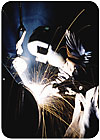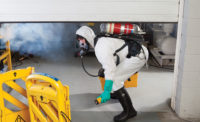
In February of this year, OSHA published an amendment to several sections of 29 CFR 1910. These changes address workers’ exposure to hexavalent chromium (Chromium VI), and include three new sections. This new ruling became effective in March, and the first compliance deadline is November 27, 2006.
Following is a brief overview of the changes and how it will affect respiratory protection for your workers who may be exposed to hexavalent chromium. For a complete copy of the OSHA amendment refer to the Federal Register, Document 71:10099-10385.
Hex chrome overview
Hexavalent chromium is chromium with a valence of positive six, in any form and in any compound, also referred to as Cr(VI). Chromium hexavalent Cr(VI) compounds, often called hexavalent chromium, exist in several forms. Chromates are often used as pigments for photography, and in pyrotechnics, dyes, paints, inks and plastics. They can also be used for stainless steel production, textile dyes, wood preservation, leather tanning and as anti-corrosion coatings.There are several health risks to long-term exposure to hexavalent chromium including lung cancer. Other risks involve problems to eyes, respiratory tract, skin and kidney.
Prior to this standard revision, the PEL (Permissible Exposure Limit) as stated in 29 CFR 1910.1000 Table Z had a ceiling value of 100 µg/m3 (100 microns per cubic meter) measured as chromium (VI) and reported as chromium anhydride (CrO3). The amount of chromium (VI) in the anhydride compound equates to a PEL of 52 µg/m3. This ceiling limit applies to all forms of hexavalent chromium, including chromium acid and chromates, lead chromate and zinc chromate. The PEL for hexavalent chromium in the construction industry was 100 µg/m3 as a time weighted average (TWA) PEL, which also equates to a PEL of 52 µg/m3.
With these amendments, a PEL for chromium (VI) for general industry, shipyards and the construction industry is established at 5 µg/m3. The new ruling also amends Table Z to reflect this change.
The amended standards are:
The three new sections are: 1910.1026; 1915.1026; and 1926.1126.
Where hex chrome is used
OSHA has identified as many as 30 industries where hexavalent chromium Cr(VI) is used and estimates approximately one million workers are exposed to Cr(VI) on a regular basis. Industries include: chromate ore; electroplating; welding, specifically stainless steel (including shipyards); painting (including aerospace industry); chromate pigment production and use; steel mills; and iron and steel foundries.Applications where Cr(VI) may be found include:
Protect your workers
Employers first need to conduct a site assessment and determine their employees’ level of exposure to hexavalent chromium. If the worksite exposure is found to be above the permissible level, then the employer should attempt to engineer out the contaminant exposure. If that is not feasible, then respiratory protection must be provided._ air-purifying full facepiece with P100 filters
_ PAPR half mask with HEPA filters, or
_ supplied air half mask.
_ PAPR full facepiece or hood with HEPA filters, or
_ Supplied air full facepiece or hood.
Sidebar: Hex Chrome compliance deadlines
_ For both of the above deadlines, all obligations of the new section applicable to the employer’s industry must be met, except engineering controls.
